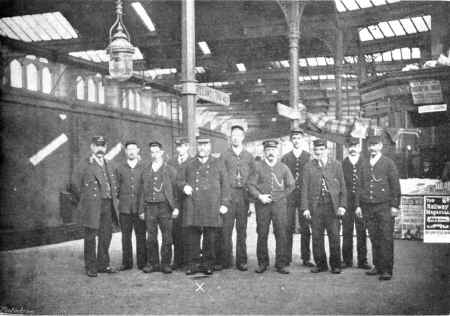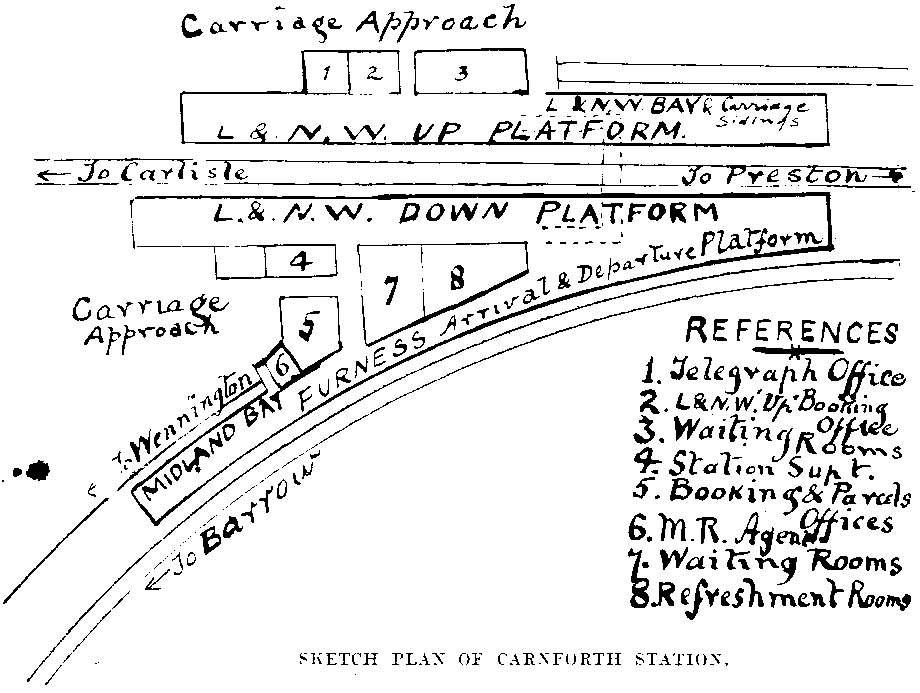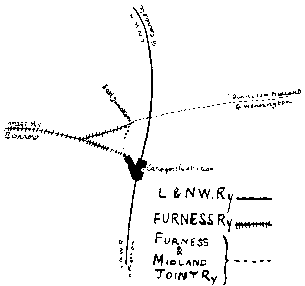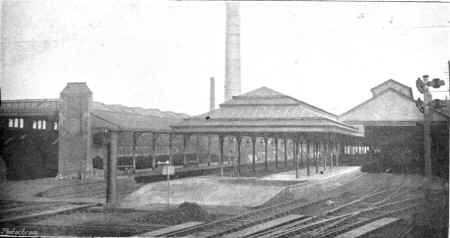THE RAILWAY MAGAZINE Notable Railway Stations. No. 23 - CARNFORTH (LONDON & NORTH-WESTERN & FURNESS JOINT)
When the Lancaster and Carlisle line was opened in 1846, Carnforth was an ordinary roadside station. It was not, indeed, till 1857, when the "Ulverston and Lancaster Railway " was formed to connect the Furness district with the main line, that it became a junction of any size. The early time-tables give the station as "Carnforth-Yealand" Yealand village and signalbox is some two miles north of Carnforth on the London and North-Western Railways main line), and the train service consisted of only five or six trains a day in each direction, for the mail coaches to and from Grange and Ulverston started from Lancaster, and crossed the sands at the corner of Morecambe Bay. But for the first ten years after the'" Ulverston and Lancaster" Railway was opened, the traffic between Yorkshire and the Furness district was carried by way of Lancaster and Carnforth, and in the 1859 time-tables a special train is given for passengers from Leeds and Bradford to Ulverston and Whitehaven. From Leeds to Ulverston the time was 4.25 hours. In 1863 the " Furness and Midland " Railway was formed to construct a line from Wennington to Carnforth, connecting; the "Little North Western" and the "Ulverston and Lancaster"-- now, of course, the Midland and Furness Railways, respectively - by a more direct route. This line, which is 9.5 miles long, was opened in June 1867. It is now the joint property of the Mid land and Furness Railways, worked by the former and maintained by the latter, and affords the Midland a convenient access to the Lake District generally. Carnforth Station is 62.75 miles from Carlisle and 236.25 miles from London by the London and North - Western Railway. The distance to St. Pancras by Hellifield and Leeds is 260 miles. It is situated just at the foot of those 31 miles of almost continuous descent from Shap Summit through Tebay and Oxenholme,and marks the point from which the West Coast route to the North ceases to be an easy road and commences its long ascent through Westmorland.
SOME OF THE STAFF AT CARNFORTH STATION, WITH MR. FARNWORTH (X), THE STATION SUPERINTENDANT IN CENTRE Carnforth Station is the joint property of the London and North Western and Furness Railways. The staff is also London and North-Western and Furness Railways joint, and the Midland Railway, which is merely a tenant in the station, possesses only an agent and two porters. The station is a fairly convenient building, although the lack of any facilities for attaching or detaching at the northern end of the London and North -Western platforms causes occasional delay, and the accommodation on the Furness side of; the station is quite inadequate when the times of up and down trains happen to coincide. The up main platform is the property of the London and North-Western, who maintain that side of the station. It has a good bay, with covered carriage sidings at the southern end, and is provided with a separate exit and booking office. On the down side, the Furness Railway's colours and architecture prevail. This platform is of a, curious Semi - island type. The accommodation for Furness trains consists merely of one side of the long platform, all roofed in, and curving away to the west from the London and North-Western lines. At its furthest end is a small covered bay. which is used by the Midland trains, and in the centre of the Platform are refreshment and dining rooms, a booking- office, and the usual supply of waiting- rooms. The chief offices of the Furness Railway are, of course, at Barrow. The plan of the lines round Carnforth, and the ground plan of the station both on page 90 , and photographs of the interior will make the arrangements of the building clear.
SKETCH MAP OF LINES AROUND CARNFORTH The Midland Railway's trains, after leaving their end of the platform branch off sharply to the right, and finally cross over the London and North-Western about half a mile north of the station. During summer, however, many of the Midland trains running between Yorkshire and the Furness district, instead of coming in and out of Carnforth Station, stop and change engines at Carnforth East Junction and proceed direct to their destination. This plan not only saves delay, but greatly relieves the pressure at the station, for, although one or two vehicles are occasionally run for the benefit of Carnforth passengers worked by the Midland Railway between the station and the East Junction , the bulk of the traffic is for Grange and beyond.
CARNFORTH STATION FROM THE SOUTH A large passenger traffic passes through the station. Few of the West Coast Scotch trains are booked to call, except some of the night expresses which stop for postal purposes, but there is a good ordinary service on the London and North-Western Railway to Windermere and Carlisle, as well as a heavy traffic passing on and off the Furness line. Through trains are run to Barrow and Whitehaven from Preston and the South. and these in some cases are united south of Carnforth to the Windermere trains, so that a certain amount of marshalling has to be done at the station. The London and North-Western Railway also gives an excellent service in connection with the Belfast boat-train leaving Carnforth for Barrow at 7.25 p.m., as the second portion of the 2.0 p.m. "corridor" from Euston stops at Carnforth at 7.16 The Midland Railway also runs a rival through coach to Barrow, which leaves St. Pancras on the l.30 p.m. Scotch express. This train is due to arrive at Carnforth at 7.15 p.m. Until 1902, the 11.30 a.m. summer Scotch express from Euston called at Carnforth for the purpose of detaching its Lake District portions, but this work has now been transferred to Preston. .
CARNFORTH STATION FROM THE SOUTH END The Midland service via Wennington to the Furness system is a large one. During the summer of 1903, twenty- four passenger trains (exclusive of excursions) passed over the "Furness and Midland " line daily, and there is a fair amount of traffic all the year round. Both Furness and Midland vehicles work on these Yorkshire trains, and the Furness Railway's corridor coaches run through to Leeds and Bradford on all the principal trains. On the through trains to the south from Barrow, via Preston, only London. and North-Western stock is used at present, but probably the time is not far distant when Furness Railway vehicles will be working on this service also. The Furness Railway had a total of seventeen arrivals and nineteen. departures at Carnforth daily during the summer of 1903, exclusive of excursions, and six trains transferred to and from the Midland Railway at the East Junction. By arrangement with the London and North-Western Railway, Furness trains are worked through between Grange and Morecambe during the summer months, and now that Morecambe is advertised as a "convenient centre for the Lake District," a continually increasing tourist traffic passes through Carnforth each season, and is apt to cause delay to the ordinary service in the morning and evening. The Furness Railway has instituted an excellent series of cheap tickets over its line, which has brought it a welcome increase in traffic and a rise in dividends. The Furness Railway has so far followed the policy of encouraging Sunday traffic as to arrange for a Sunday train to and from Morecambe during the season. Till 1902, the London and North-Western Railway had left Morecambe without any Sunday service whatever.
CARNFORTH STATION As a postal centre, Carnforth is very important. It is the head of a large district---so large that a letter posted at St. Bees for Whitehaven-a direct distance of 4.5 miles-actually makes a journey of 144 miles via Carnforth. The postal work at the station commences with the arrival of the Furness mails at 9.0 and 9.52 p.m. At 10.4 the London and North-Western 8.42 p.m. up from Carlisle (the old " Limited ") calls, followed at 10.44 by the up postal train, leaving Carlisle at 9.22 p.m. The transfer to and from these trains is heavy, and at 12.0 midnight the Midland send out their" Normanton mail " with traffic for Yorkshire from the Furness district and the North. A corresponding Midland train arrives with mails from Leeds and Bradford at 12.35 a.m., and the postal work culminates in the arrival of the West Coast down "postal" at l.34 a.m. Apart from its importance as a post-office train, this express which leaves Euston at 8.30 p.m. is interesting as supplying the fastest London and North-Western booking north of Crewe. It is timed from Preston to Carnforth (27.25 miles in 29 minutes, and from Carnforth to Carlisle 62.75 miles in 70 minutes. The train carries no ordinary passengers, and its load averages about 215 tons. A further consignment of mails reaches Carnforth at 3.51 a.m. off the 10.0 p.m. from Euston, and the mail for the Furness district leaves at 4.25 a.m.
FURNESS RAILWAY TRAIN RUNNING OVER THE L.& N.W.R.
The Midland Railway's goods trains are all handed over at Carnforth East Junction, but the goods working of the three companies is joint, under. the management of Mr. Unsworth. The London and North-Western Railway has also a considerable number of coke-trains coming down to the Carnforth ironworks from Darlington district via Tebay and corresponding empty wagon trains going North. Fortunately, natural conditions have here favoured the railway, for the loaded trains have all the gradients in their favour, and are allowed to take a maximum load of 55 wagons. All London and North-Western specials of cattle and meat trains from the North call at Carnforth for examination, so that the station is busy during the whole twenty- four hours. The three railways each own separate engine-sheds. The London and North-Western keep several of the latest type of goods compounds working the coke traffic round Carnforth, but none of this company's passenger engines are stationed there, so that many of the passenger trains in the neighbourhood have to be worked by goods engines - a practice which has lately been carried to very undesirable lengths. The Furness Railway's sheds hold several of their latest types of passenger locomotives, and at the Midland sheds, which are situated about half a mile down the Wennington branch, and are really the joint property of the Furness Railway and Midland Railway, a fair number of engines are kept. The locomotives of the different companies do not work regularly over each other's lines, but the Furness Railway possesses running powers over the London and North-Western as far as Lancaster, which they exercised last in 1896, and it also provides shunting power in the goods yard in turn with the London and North-Western Railway.
EAST JUNCTION CARNFORTH,
WHERE SUCH THROUGH TRAINS The present Stationmaster at Carnforth is Mr. Farnworth, who entered the London and North-Western Railway's service at Lancaster in 1875, and was appointed to Carnforth in 1895. His predecessor was Mr. Haythornthwaite, who is now Superintendent of the joint station at Carlisle. The Carnforth platform staff numbers forty-one, and there are also fifteen London and North-Western signalmen, and forty brakes- men, belonging to the three companies, attached to the station. The management of the station is entirely in the hands of the London and North-Western and Furness Railways. The Midland agent is Mr. Peel. R. E. CHARLEWOOD.
"Railway Magazine" February 1904. I would like to thank "Railway Magazine" for kindly giving me permission to re-produce this article.
|
 CARNFORTH owes
its importance as a railway centre to the fact that it is the junction of the Furness
system with the London and North-Western main line. Unlike Lancaster, Carnforth has few
associations with the early railway history of the north-west of England; the town is
small and unimportant, and, apart from the fact that a large interchange of passenger and
postal traffic takes place at the station, Carnforth would still be an insignificant
village on the borders of Lancashire and Westmorland.
CARNFORTH owes
its importance as a railway centre to the fact that it is the junction of the Furness
system with the London and North-Western main line. Unlike Lancaster, Carnforth has few
associations with the early railway history of the north-west of England; the town is
small and unimportant, and, apart from the fact that a large interchange of passenger and
postal traffic takes place at the station, Carnforth would still be an insignificant
village on the borders of Lancashire and Westmorland. 






